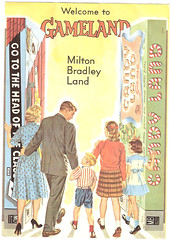I was digging through some old board games we have stored in the attic last weekend. In one box I came across an advertising flier that was a common insert in games during the sixties.
What caught my eye (besides the astonishing fact that whoever originally owned the game had not discarded it and that we had not discarded it either) was the image on the cover. The stereotypical 1950's family -- Mom, Dad, and three smartly dressed children (is the son wearing a bow tie?!) -- walking through gates made from giant board game boxes. The image itself is surreal enough. But when you consider that this was not some post-war hallucinogenic vision but a 1960's retro marketing view of what American families wanted to believe they looked like, it is also weirdly delusional.
Did we really think we looked (and acted) like that? Based on my childhood in Ohio, I would say no. But I think many parents wished their families looked like that and I can only assume the flier was intended for those parents not their children.
And today? I haven't looked inside any modern major board games recently. (I mostly play old ones, several that are listed in the flier pictured above!) But based on advertising fliers in the paper, most games are being sold to be played by children either alone or with their friends, not their parents. I don't remember seeing a lot of adults in the advertising for games and toys recently. (With one exception. More on that later.)
The advertising in the Sunday papers tend to contain product images, not entire scenes, so they are not totally representative. But over the holidays we received a special toy catalog from Target. Of the 57 pictures showing people with the products, 50 depicted children alone, 7 depicted two children playing together, and none contained any adults. Stranger still, the one picture of a child playing a board game (what one might imagine most requires multiple players) she is playing alone!
So have we reached a point where society no longer expects parents to participate in their children's play and games? The predominance of video games (which are often single-player or only multiplayer online) and "licensed" toys and games makes families playing together difficult. It can be hard for an adult to acclimatize themselves to game characters based on pre-teen TV shows such as Hannah Montana or Bakugon. (Although the game play itself is usually very traditional or simplistic.)
I mentioned before that there is an exception. If it wasn't obvious, the exception is Nintendo. The entire design and marketing campaign of the Wii video game console is that games are to be played together, often as a family. The 2008 holiday catalog for Nintendo has 17 pictures of people playing, 8 are pictures of groups playing, and half of those are multi-generational groups.
Nintendo not only defied the accepted wisdom of video game marketing (16-24 year old males playing by themselves), they defied the accepted wisdom of the game and toy industry as a whole. Neither segment has completely recovered from the result, nor learned to accept that they may have been wrong.
We are beginning to see signs that Sony and Microsoft acknowledge this previously "silent majority" market -- the new Xbox 360 avatars are an example. But the toy and game industry still does not seem ready to believe their audience contains anyone over the age of, say, 14...


1 comment:
I didn't mention it, because it was not germane to my arguments about game marketing, but there is an active and vibrant sub-culture involved in adult board games. Besides the distinct D&D sub-culture, there are many people who play games such as Carcassonne, Cartagena, Clue, etc. You will find few of these games in department stores, but for anyone is interested in intelligent board games for families, sites such as Fun Again and Board Game Geek are good starting points.
Post a Comment